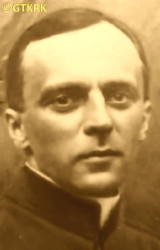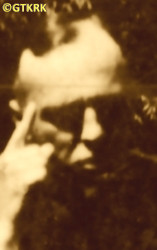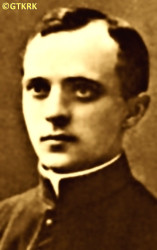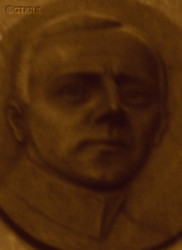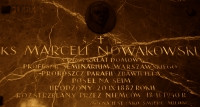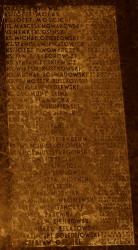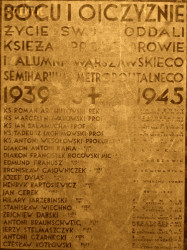Roman Catholic
St Sigismund parish
05-507 Słomczyn
85 Wiślana Str.
Konstancin deanery
Warsaw archdiocese, Poland
full list:
displayClick to display full list

searchClick to search full list by categories
wyświetlKliknij by wyświetlić pełną listę po polsku

szukajKliknij by przeszukać listę wg kategorii po polsku

Martyrology of the clergy — Poland
XX century (1914 – 1989)
personal data
surname
NOWAKOWSKI
forename(s)
Marcel Vaclav (pl. Marceli Wacław)
function
diocesan priest
creed
Latin (Roman Catholic) Church RCmore on
en.wikipedia.org
[access: 2014.09.21]
diocese / province
Warsaw archdiocesemore on
en.wikipedia.org
[access: 2013.05.19]
RC Military Ordinariate of Polandmore on
en.wikipedia.org
[access: 2014.12.20]
academic distinctions
Doctor of Sacred Theology
honorary titles
pontifical prelatemore on
en.wikipedia.org
[access: 2014.11.14]
(1925)
Honorary Chaplain of His Holinessmore on
en.wikipedia.org
[access: 2020.09.29]
(c. 1921)
„Cross of Valour”more on
en.wikipedia.org
[access: 2019.04.16]
date and place
of death
22.01.1940

Palmirytoday: Czosnów gm., Nowy Dwór Mazowiecki pov., Masovia voiv., Poland
more on
en.wikipedia.org
[access: 2022.01.28]
alt. dates and places
of death
18.02.1940
Warsawtoday: Warsaw city pov., Masovia voiv., Poland
more on
en.wikipedia.org
[access: 2021.10.09]
details of death
During Polish–Russian war of 1919‐1921 chaplain of 5th Cavalry Regiment of Polish Army. The Regiment took part in the pre‐emptive Polish Kiev expedition, which began on 25.04.1920. On 24.05.1920 it participated in a seven‐hour battle with the Russians near Kivshovata, in the Bila Tserkva region in Ukraine. A few days later, the Russians began a major counterattack. During the retreat of Polish troops, the Regiment took part in battles near Rivne, Berestechko and Kholoyiv, delaying the attack of the Rus. Первая Конная армия (Eng. 1st Cavalry Army), commanded by Semyon Budyonny. Then, in 08.1920, it participated in the Lviv defense line — among others.
at Peremyshlyany, Bibrka and Rohatyn — thanks to which the Rus. Первая Конная армия did not manage to support the large offensive of the Russian Northern Front under the command of Mikhail Tukhachevsky, contributing to the Russian defeat in the decisive Battle of Warsaw on c. 15.08.1920 (known as the „Miracle on the Vistula”).
Then, on 23.08.1920, volunteered to join the Regiment as its chaplain. The ousting of the Russians began, during which the Regiment gained fame on 23.09.1920 for its charge near Izyaslav. The 1st Cavalry Brigade, in the ranks of which his Regiment fought, took over 2,000 prisoners, 32 machine guns and 3 guns, defeating Russian units several times more numerous. From there the Regiment took part in the pursuit of the Russians towards Starokostyantyniv and then Novokostyantyniv, east of Proskuriv. Was there when the armistice of 18.10.1920 went into force. Prob. then returned to Warsaw and parliamentary duties.
After German and Russian invasion of Poland in 09.1939 and start of the World War II, after start of German occupation, for the first time arrested by the Germans on 04.10.1940.
Released.
On 08.12.1940 (according to other sources already on 09.10.1939) arrested again, together with his vicar, Fr Bronislav Wróblewski, and a sacristan.
Jailed in Daniłowiczowska Str. and Szucha Alley interrogation arrests and prisons in Warsaw.
16.01.1940 tried by a German genocidal kangaroo court — for conducting anti–German activities, distributing anti–German leaflets in his parish church and facilitating the departure abroad of Olga Helene Sikorska, wife of General Vladislav Sikorski, the prime minister of Polish government, then in exile, who at the beginning of 01.1940 left the Germ. Generalgouvernement (Eng. General Governorate), the occupation unit run by the Germans and organized in central Poland, dressed as a maid of an Italian woman, Luciana Frassati–Gawrońska — to the death penalty.
Did not admit to the charges — according to witnesses, in his speech „accused and judged the judges and the entire German nation, prophesying their defeat in the war”.
Sentenced to death.
Murdered in a mass execution of Polish Warsaw intelligentsia in Palmiry.
alt. details of death
According to other sources murdered in Warsaw Parliament gardens.
cause of death
mass murder
perpetrators
Germans
sites and events
PalmiryClick to display the description, Warsaw (Szuch Ave.)Click to display the description, Warsaw (Daniłowiczowska)Click to display the description, «Intelligenzaktion»Click to display the description, Collective responsibility („Hostages”)Click to display the description, GeneralgouvernementClick to display the description, Ribbentrop‐MolotovClick to display the description, Pius XI's encyclicalsClick to display the description, Polish‐Russian war of 1919‐1921Click to display the description
date and place
of birth
20.09.1881Birth certification on:
photos.szukajwarchiwach.gov.pl
[access: 2025.08.19]

Przybyszewtoday: Promna gm., Białobrzegi pov., Masovia voiv., Poland
more on
en.wikipedia.org
[access: 2022.01.28]
parents
NOWAKOWSKI Stanislav
🞲 ?, ? — 🕆 ?, ?

MROZIEWICZ Catherine
🞲 ?, ? — 🕆 ?, ?
baptism
13.11.1881Birth certification on:
photos.szukajwarchiwach.gov.pl
[access: 2025.08.19]

Przybyszewtoday: Promna gm., Białobrzegi pov., Masovia voiv., Poland
more on
en.wikipedia.org
[access: 2022.01.28]
St Peter and St Paul the Apostles RC church
presbyter (holy orders)
ordination
1909

positions held
1926 – 1940
parish priest — WarsawŚródmieście district
today: Warsaw city pov., Masovia voiv., Poland
more on
en.wikipedia.org
[access: 2022.01.28] ⋄ Most Holy Saviour RC parish ⋄ Warsaw‐in‐urbedeanery name
today: Warsaw city pov., Masovia voiv., Poland RC deanery
1937 – 1939
pro‐synodal examiner — Warsawtoday: Warsaw city pov., Masovia voiv., Poland
more on
en.wikipedia.org
[access: 2021.10.09] ⋄ Metropolitan Curia ⋄ Warsaw RC archdiocese
1924 – 1932
synod judge — Archbishop's Metropolitan Court ⋄ Warsaw RC archdiocese
1928 – 1930
parliamentary deputy — Seym i.e. Parliament (2nd Term), Second Polish Republic — on behalf of the National Democracy representation (ZSLN, ZLN, ChZJN, Catholic–National List)
1922 – 1927
parliamentary deputy — Seym i.e. Parliament (1st Term), Second Polish Republic — on behalf of the National Democracy representation (ZSLN, ZLN, ChZJN, Catholic–National List)
1919 – 1922
parliamentary deputy — Seym i.e. Parliament (Legislative), Second Polish Republic — on behalf of the National Democracy representation (ZSLN, ZLN, ChZJN, Catholic–National List)
1910 – 1926
professor — Warsawtoday: Warsaw city pov., Masovia voiv., Poland
more on
en.wikipedia.org
[access: 2021.10.09] ⋄ Metropolitan Theological Seminary — lecturer in history of philosophy and the Church history
1916 – 1923
censor of religious books (Lat. censores librorum) — Warsaw RC archdiocese
secretary — personal, to Archbishop Alexander Kakowski
1916 – 1924
vicar — Warsawtoday: Warsaw city pov., Masovia voiv., Poland
more on
en.wikipedia.org
[access: 2021.10.09] ⋄ Holy Cross RC parish ⋄ Warsaw‐in‐urbedeanery name
today: Warsaw city pov., Masovia voiv., Poland RC deanery
1911 – 1915
vicar — Warsawtoday: Warsaw city pov., Masovia voiv., Poland
more on
en.wikipedia.org
[access: 2021.10.09] ⋄ All the Saints RC parish ⋄ Warsaw‐in‐urbedeanery name
today: Warsaw city pov., Masovia voiv., Poland RC deanery
1909 – 1910
vicar — Wiskitkitoday: Wiskitki gm., Żyrardów pov., Masovia voiv., Poland
more on
en.wikipedia.org
[access: 2022.04.12] ⋄ All the Saints and St Stanislav the Bishop and Martyr RC parish ⋄ Grodzisk Mazowieckitoday: Grodzisk Mazowiecki gm., Grodzisk Mazowiecki pov., Masovia voiv., Poland
more on
en.wikipedia.org
[access: 2021.04.01] RC deanery
1909
vicar — Zdunytoday: Zduny gm., Łowicz pov., Łódź voiv., Poland
more on
en.wikipedia.org
[access: 2022.01.28] ⋄ St James the Apostle RC parish ⋄ Łowicztoday: Łowicz urban gm., Łowicz pov., Łódź voiv., Poland
more on
en.wikipedia.org
[access: 2021.12.18] RC deanery
c. 1905 – 1909
PhD student — Innsbrucktoday: Innsbruck‐Land dist., Tyrol state, Austria
more on
en.wikipedia.org
[access: 2024.03.19] ⋄ theology, Leopold and Francis University — postgraduate specialised studies, crowned with Sacred Theology PhD degree
c. 1905
student — Munichtoday: Bavaria state, Germany
more on
en.wikipedia.org
[access: 2022.04.12] ⋄ history
1904 – 1905
student — Rometoday: Rome prov., Lazio reg., Italy
more on
en.wikipedia.org
[access: 2021.12.18] ⋄ law and theology, „Gregorianum” [i.e. Lat. Pontificia Universitas Gregoriana (Eng. Pontifical Gregorian University)] — resident of the Resurrectionists' house at via Marconi; also: learning Italian and French, and history of art
1899 – 1904
student — Warsawtoday: Warsaw city pov., Masovia voiv., Poland
more on
en.wikipedia.org
[access: 2021.10.09] ⋄ philosophy and theology, Metropolitan Theological Seminary
activist — political, social and educational — outstanding orator, speaker and preacher, especially during significant national events
co‐organizer of the Polish Red Cross and the Society for the Protection of Prisoners during World War I
author of i.a. „Martin Luther. Creator of the Pseudo–Reformation” („Handbook Church Encyclopedia”, Kraków, 1916), „Beware of Jews and Bolsheviks” (Częstochowa, 1918), „Criminals of the 20th century. Jews – Bolsheviks” (Radom, 1919); publicist at „Wiadomości Archidiecezji Warszawskiej” (Eng. „Warsaw Archdiocese News”), „Gazeta Warszawska” (Eng. „Warsaw Gazette”), „Warszawski Dziennik Narodowy” (Eng. „Warsaw National Daily”)
others related
in death
KRAWCZYKClick to display biography John Ignatius, MĘŻYŃSKIClick to display biography Francis, PIENIĄŻEKClick to display biography Casimir, SAJNAClick to display biography Sigismund Joseph
sites and events
descriptions
Palmiry: From 12.1939 till 07.1941 Germany — units of genocidal SS and Germ. Schutzpolizei (Eng. preventive police), i.e. Schupo —‐ in mass executions, murdered in Palmiry c. 1,700‐2,200 Poles from Warsaw, mainly the intelligentsia, as part of the «AB‐aktion», as well as Jews. The first executions took place on December 07‐08.12.1939 (70+80 victims). Among the biggest were: 26.02.1940 — c. 190 people; 02.04.1940 — c. 100. The victims were brought to the execution site by trucks, usually at dawn. Their luggage was collected at the site. Sometimes were restrained and/or blindfolded. Next were led to the edge of the dug pits where they were shot with machine gun fire. Those giving signs of life were finished off with small arms. The pits were filled in and pine thickets planted. (more on: en.wikipedia.orgClick to attempt to display webpage
[access: 2022.08.17])
Warsaw (Szuch Ave.): At 25 John Christian Szuch Avenue in Warsaw — then in German‐occupied Germ. Generalgouvernement (Eng. General Governorate) — at the heart of so‐called police district (with status Germ. „Nur für Deutsche” — End. „Only for Germans”), from 07.10.1939 headquarters of Germ. Der Kommandeur Sicherheitspolizei und des Sicherheitsdienst für den Distrikt Warschau (Eng. Bureau of Security Police and Security Service Commander for Warsaw District), Germans organised Warsaw HQ of Germ. Geheime Staatspolizei (Eng. Secret State Police), i.e. Gestapo. In the basements a Germ. Hausgefängnis (Eng. Detention Centre) was set. Prisoners from Warsaw prisons, mainly Pawiak (twice a day) where brought there for interrogations. Tortures were widely used — „beating (with a club, whip, rubber, iron poles, butts of pistols), kicking, setting dogs on, burning flesh with cigarettes or an iron rod (especially the face, heels and abdomen), crushing fingers and genitals, hanging on the hands at the back, breaking bones, knocking out front teeth, damaging eyeballs, strangling with a gas mask with a damaged absorber, irritating with electric current, pouring water into the nose with gagged mouth, dipping the prisoner's head in a bucket with water and holding it there until signs of suffocation, plucking out nails and driving steel needles under them” (Wikipedia). Often tortures were done with family members present. Even women in last months of pregnancy were tortured. During Warsaw Uprising of 08‐10.1944 Germans conducted mass executions in the building. Number of victims — unknown (in 06.1946 in Szucha Avenue building basements 5.5. tons of human ashes and bones were discovered). (more on: en.wikipedia.orgClick to attempt to display webpage
[access: 2019.02.02])
Warsaw (Daniłowiczowska): Warsaw central detention centre — so‐called Centralniak — used by the Germans during occupation of Poland as a court prison where people suspected of political crimes where held. Many were subsequently taken to villages n. Warsaw (e.g. Magdalenka and Anin) and executed. (more on: pl.wikipedia.orgClick to attempt to display webpage
[access: 2013.08.17])
«Intelligenzaktion»: German: «Intelligenzaktion» (English: „Intelligence Action”) — a German program of extermination of the Polish elite, mainly the intelligentsia and leadership layers, carried out from the beginning of the occupation in w 09.1939 to 04.1940, mainly in territories directly annexed to Germany, but also in the so‐called Germ. Generalgouvernement (Eng. General Governorate), where it was called «AB‐aktion». In the first phase, immediately after the beginning of the German occupation, during military operations carried out by the Germ. Wehrmacht (Eng. Armed Forces) and the genocidal units of the Germ. Einsatzgruppen (Eng. Operational Groups) of the Germ. Sicherheitspolizei (Eng. Security Police), i.e. SiPo, and Germ. Sicherheitsdienst des Reichsführers SS (Eng. Security Service of the Reichsführer SS), i.e. SD, organized by the Germ. Reichssicherheitshauptamt (Eng. Reich Main Security Office), i.e. RSHA, which followed the troops, carried out under the Germ. Unternehmen „Tannenberg” (Eng. Operation „Tannenberg”) — based on the so‐called Germ. Sonderfahndungsliste (Eng. Special Wanted Lists), i.e. proscription lists of Poles considered particularly dangerous to the Third Reich, prepared by the Zentralstelle II/P (Polen) unit of the German RSHA. Later, implemented by the German civilian occupation authorities and the genocidal unit of the Germ. Volksdeutscher Selbstschutz (Eng. Ethnic Germans Self‐Defense), whose members were Germ. Volksdeutsche (Eng. Ethnic Germans), i.e. representatives of the German minority in Poland. According to various sources, these lists, at the beginning of 09.1939, could have contained the details of 61,000—88,000 „dangerous” Poles — although these figures cannot be confirmed. In total, during this genocide, c. 50,000 teachers, Catholic priests, representatives of the landed gentry, freelancers, social and political activists, and retired military personnel were systematically and methodically murdered. Another 50,000 were sent to concentration camps, where only a negligible percentage survived. (more on: en.wikipedia.orgClick to attempt to display webpage
[access: 2014.10.04])
Collective responsibility („Hostages”): A criminal practice implemented by the Germans in the occupied territories of Poland, applied from the very first day of World War II. At its core was an appointment and public announcement of a list of names of selected people whose lives depended on absolute compliance with German orders. Any violation of these ordinances, by any person, regardless of the circumstances, resulted in the murder of the designated „hostages”. In the first days of the war and occupation, it was used i.a. by the German Wehrmacht army to prevent acts of continuation of the defense by the Poles. Later, especially in the German‐run General Governorate, it was part of the official policy of the occupation authorities — collective responsibility for any acts of resistance to the occupier's practices. For the life of one German, even if death was due to customary reasons, the Germans carried out executions from a dozen to even a hundred Poles previously designated as „hostages”.
Generalgouvernement: After the Polish defeat in the 09.1939 campaign, which was the result of the Ribbentrop‐Molotov Pact and constituted the first stage of World War II, and the beginning of German occupation in part of Poland (in the other, eastern part of Poland, the Russian occupation began), the Germans divided the occupied Polish territory into five main regions. In two of them new German provinces were created, two other were incorporated into other provinces. However, the fifth part was treated separately, and in a political sense it was supposed to recreate the German idea from 1915 (during World War I, after the defeat of the Russians in the Battle of Gorlice in 05.1915) of creating a Polish enclave within Germany. Illegal in the sense of international law, i.e. Hague Convention, and public law, managed by the Germans according to separate laws — especially established for the Polish Germ. Untermenschen (Eng. subhumans) — till the Russian offensive in 1945 it constituted part of the Germ. Großdeutschland (Eng. Greater Germany). Till 31.07.1940 formally called Germ. Generalgouvernement für die besetzten polnischen Gebiete (Eng. General Government for the occupied Polish lands) — later simply Germ. Generalgouvernement (Eng. General Governorate), as in the years 1915‐1918. From 07.1941, i.e. after the German attack on 22.06.1941 against the erstwhile ally, the Russians, it also included the Galicia district, i.e. the Polish pre‐war south‐eastern voivodeships. A special criminal law was enacted and applied to Poles and Jews, allowing for the arbitrary administration of the death penalty regardless of the age of the „perpetrator”, and sanctioning the use of collective responsibility. After the end of the military conflict of the World War UU, the government of the Germ. Generalgouvernement was recognized as a criminal organization, and its leader, governor Hans Frank, guilty of war crimes and crimes against humanity and executed. (more on: en.wikipedia.orgClick to attempt to display webpage
[access: 2024.12.13])
Ribbentrop‐Molotov: Genocidal Russian‐German alliance pact between Russian leader Joseph Stalin and German leader Adolf Hitler signed on 23.08.1939 in Moscow by respective foreign ministers, Mr. Vyacheslav Molotov for Russia and Joachim von Ribbentrop for Germany. The pact sanctioned and was the direct cause of joint Russian and German invasion of Poland and the outbreak of the World War II in 09.1939. In a political sense, the pact was an attempt to restore the status quo ante before 1914, with one exception, namely the „commercial” exchange of the so‐called „Kingdom of Poland”, which in 1914 was part of the Russian Empire, fore Eastern Galicia (today's western Ukraine), in 1914 belonging to the Austro‐Hungarian Empire. Galicia, including Lviv, was to be taken over by the Russians, the „Kingdom of Poland” — under the name of the General Governorate — Germany. The resultant „war was one of the greatest calamities and dramas of humanity in history, for two atheistic and anti‐Christian ideologies — national and international socialism — rejected God and His fifth Decalogue commandment: Thou shall not kill!” (Abp Stanislav Gądecki, 01.09.2019). The decisions taken — backed up by the betrayal of the formal allies of Poland, France and Germany, which on 12.09.1939, at a joint conference in Abbeville, decided not to provide aid to attacked Poland and not to take military action against Germany (a clear breach of treaty obligations with Poland) — were on 28.09.1939 slightly altered and made more precise when a treaty on „German‐Russian boundaries and friendship” was agreed by the same murderous signatories. One of its findings was establishment of spheres of influence in Central and Eastern Europe and in consequence IV partition of Poland. In one of its secret annexes agreed, that: „the Signatories will not tolerate on its respective territories any Polish propaganda that affects the territory of the other Side. On their respective territories they will suppress all such propaganda and inform each other of the measures taken to accomplish it”. The agreements resulted in a series of meeting between two genocidal organization representing both sides — German Gestapo and Russian NKVD when coordination of efforts to exterminate Polish intelligentsia and Polish leading classes (in Germany called «Intelligenzaktion», in Russia took the form of Katyń massacres) where discussed. Resulted in deaths of hundreds of thousands of Polish intelligentsia, including thousands of priests presented here, and tens of millions of ordinary people,. The results of this Russian‐German pact lasted till 1989 and are still in evidence even today. (more on: en.wikipedia.orgClick to attempt to display webpage
[access: 2015.09.30])
Pius XI's encyclicals: Facing the creation of two totalitarian systems in Europe, which seemed to compete with each other, though there were more similarities than contradictions between them, Pope Pius XI issued in 03.1937 (within 5 days) two encyclicals. In the „Mit brennender Sorge” (Eng. „With Burning Concern”) published on 14.03.1938, condemned the national socialism prevailing in Germany. The Pope wrote: „Whoever, following the old Germanic‐pre‐Christian beliefs, puts various impersonal fate in the place of a personal God, denies the wisdom of God and Providence […], whoever exalts earthly values: race or nation, or state, or state system, representatives of state power or other fundamental values of human society, […] and makes them the highest standard of all values, including religious ones, and idolizes them, this one […] is far from true faith in God and from a worldview corresponding to such faith”. On 19.03.1937, published „Divini Redemptoris” (Eng. „Divine Redeemer”), in which criticized Russian communism, dialectical materialism and the class struggle theory. The Pope wrote: „Communism deprives man of freedom, and therefore the spiritual basis of all life norms. It deprives the human person of all his dignity and any moral support with which he could resist the onslaught of blind passions […] This is the new gospel that Bolshevik and godless communism preaches as a message of salvation and redemption of humanity”… Pius XI demanded that the established human law be subjected to the natural law of God , recommended the implementation of the ideal of a Christian state and society, and called on Catholics to resist. Two years later, National Socialist Germany and Communist Russia came together and started World War II. (more on: www.vatican.vaClick to attempt to display webpage
[access: 2023.05.28], www.vatican.vaClick to attempt to display webpage
[access: 2023.05.28])
Polish‐Russian war of 1919‐1921: War for independence of Poland and its borders. Poland regained independence in 1918 but had to fight for its borders with former imperial powers, in particular Russia. Russia planned to incite Bolshevik‐like revolutions in the Western Europe and thus invaded Poland. Russian invaders were defeated in 08.1920 in a battle called Warsaw battle („Vistula river miracle”, one of the 10 most important battles in history, according to some historians). Thanks to this victory Poland recaptured part of the lands lost during partitions of Poland in XVIII century, and Europe was saved from the genocidal Communism. (more on: en.wikipedia.orgClick to attempt to display webpage
[access: 2014.12.20])
sources
personal:
pl.wikipedia.orgClick to attempt to display webpage
[access: 2012.11.23], bs.sejm.gov.plClick to attempt to display webpage
[access: 2013.07.06], jan.zaryn.salon24.plClick to attempt to display webpage
[access: 2016.03.14], photos.szukajwarchiwach.gov.plClick to attempt to display webpage
[access: 2025.08.19], salontradycjipolskiej.plClick to attempt to display webpage
[access: 2020.06.05], www.prawy.plClick to attempt to display webpage
[access: 2016.03.14]
original images:
salontradycjipolskiej.plClick to attempt to display webpage
[access: 2020.06.05], commons.wikimedia.orgClick to attempt to display webpage
[access: 2016.03.14], salontradycjipolskiej.plClick to attempt to display webpage
[access: 2020.06.05], prawy.plClick to attempt to display webpage
[access: 2018.11.18], commons.wikimedia.orgClick to attempt to display webpage
[access: 2015.09.30]
LETTER to CUSTODIAN/ADMINISTRATOR
If you have an Email client on your communicator/computer — such as Mozilla Thunderbird, Windows Mail or Microsoft Outlook, described at WikipediaPatrz:
en.wikipedia.org, among others — try the link below, please:
LETTER to CUSTODIAN/ADMINISTRATORClick and try to call your own Email client
If however you do not run such a client or the above link is not active please send an email to the Custodian/Administrator using your account — in your customary email/correspondence engine — at the following address:

giving the following as the subject:
MARTYROLOGY: NOWAKOWSKI Marcel Vaclav
To return to the biography press below:
 Click to return to biography
Click to return to biography








